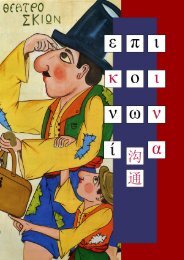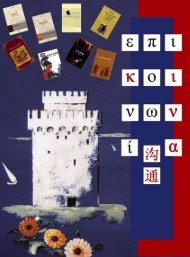Fifth Issue
Fifth Issue
Fifth Issue
You also want an ePaper? Increase the reach of your titles
YUMPU automatically turns print PDFs into web optimized ePapers that Google loves.
Indian and Indonesian influences exist among the<br />
Shadow Theaters of Southeast Asia (Malaysia,<br />
Cambodia and Thailand), where the types of theater<br />
traditions, of shape and appearance of figures, seem to<br />
have followed non – unidirectional routes and may have<br />
different points of origin.<br />
In China, the first evidence of<br />
Shadow Theater dates back to the<br />
Song Dynasty (960 – 1279 A.D.),<br />
though, references to related events<br />
exist prior to that time, as for instance,<br />
a famous story from the Han Dynasty<br />
(206 B.C. – 220 A.D.), which became<br />
widely accepted as narrating the<br />
origin of Chinese Shadow Theater: when the favorite concubine of the Han emperor Wu<br />
died, a court magician, who wanted to comfort him, used shadows and candles to make<br />
the image of the concubine appear behind a curtain. Albeit unlikely as origin of the<br />
Chinese Shadow Theater, the story became popular in the 11 th century.<br />
During the Tang Dynasty (618-907 A.D.), the art of<br />
storytelling was combined with the illustration of narratives<br />
with pictures on paper screens or scrolls. Besides, the papercuts,<br />
pasted on lanterns, screens and windows, with lights<br />
illuminating them from behind, created pictures similar to those<br />
of the Shadow Theater, and can be considered as the inspiration<br />
for the Shadow puppets.<br />
10






